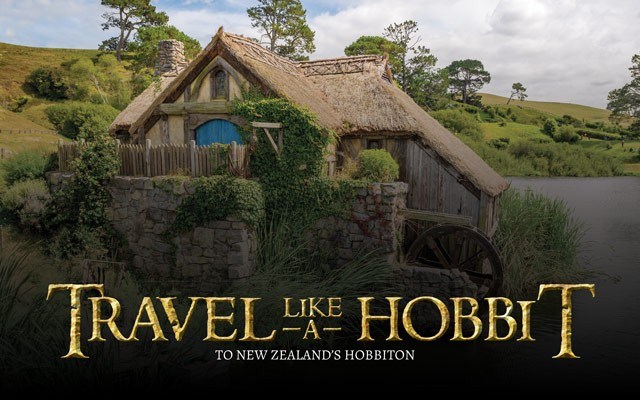When J.R.R. Tolkien penned the epic fantasy series The Lord of the Rings and The Hobbit, he dreamed and wrote about a bucolic setting for The Shire from Middle-earth — with Hobbiton as hometown for the race of wee hobbits. His descriptions were forged from his memories of places he had been, as well as from his studies of mythical lands he had read about in ancient texts. The place had to be rural and capture the simple joys of country life.
It is with this background in mind that New Zealand filmmaker Peter Jackson understood the need to bring Middle-earth alive when he set about searching for just the right location for The Lord of the Rings. He was looking for a lush and stunning countryside with rolling green paddocks and a giant tree. Finally, after an exhaustive aerial search, Jackson and his scouting crew found an ideal location in the Waikato township knolls of Matamata, located on the North Island of New Zealand. Here, on a working sheep and beef farm, they would recreate Frodo's mythical journey, set in a time somewhere between the dawning of fairies and the rule of men.
Site construction began in 1999 for The Lord of the Rings, with some plantings done up to a year in advance so they would look natural. Then, with his trademark attention to detail, Jackson transformed the 12-acre site into the Hobbiton movie set. However, after the filming was over and in typical movie fashion of the day, due to liability issues, the set was torn down.
Then came the announcement of a prequel trilogy involving The Hobbit. The films included The Hobbit: An Unexpected Journey, The Hobbit: The Desolation of Smaug, and The Hobbit: There and Back Again. So, the set was rebuilt in 2011 for the filming of where it all started — The Hobbit — and has now become a permanent fixture and international attraction to lovers of Middle-earth. The home of Bilbo and Frodo is alive with flowers, crops, and a sundry of items that hobbits find useful in their everyday lives. As expected, Peter Jackson's trilogy based on J.R.R. Tolkien's fantasy novel The Hobbit, went on to reap a slew of awards, including seven Academy Awards.
First opened in 2002, Hobbiton is one of New Zealand's most popular attractions, easily attracting upwards of 350,000 people annually. Middle-earth comes alive with 44 hobbit holes, the mill and Party Tree, bridges, gardens, and Bag End — where Frodo and Bilbo's adventures began, and the Green Dragon Inn. In fact, the Green Dragon is an exact movie replica, and is a spot where you can sip a cold beer or cider. Be sure to sample some traditional Hobbit fare like beef and ale pie. Then check out the Shire Store for hobbit memorabilia as a remembrance of your journey to Middle-earth.
While some of the hobbit holes, including the house of Bilbo Baggins, are at a scale for human exploration, many are miniature in size and include pint-sized clothes hung out to dry, honey pots, baskets of wool to spin, brooms, rakes, chairs, flowers, drying herbs, and even cabbage gardens. All of the hobbit homes represent the painstaking detail that went into the production of Jackson's films.
A year-round tour of the Hobbiton movie set, which takes about two hours, is US$79. This includes transport to and from the set and a complimentary drink at the Green Dragon Inn. A guide narrates the background details of the set and how it was built. The Evening Dinner Tour at US$190 is a special luminary treat where you enjoy a banquet of Hobbit fare, along with a nighttime tour of the fantasy land of Hobbiton. Just like in the days of the hobbits, an authentic handheld lantern will help guide the way.
If you go:




